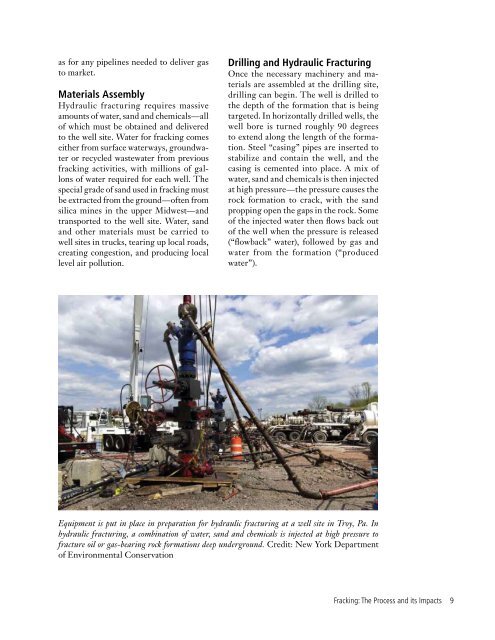The Costs of Fracking
The Costs of Fracking vMN.pdf - Environment Minnesota
The Costs of Fracking vMN.pdf - Environment Minnesota
You also want an ePaper? Increase the reach of your titles
YUMPU automatically turns print PDFs into web optimized ePapers that Google loves.
as for any pipelines needed to deliver gas<br />
to market.<br />
Materials Assembly<br />
Hydraulic fracturing requires massive<br />
amounts <strong>of</strong> water, sand and chemicals—all<br />
<strong>of</strong> which must be obtained and delivered<br />
to the well site. Water for fracking comes<br />
either from surface waterways, groundwater<br />
or recycled wastewater from previous<br />
fracking activities, with millions <strong>of</strong> gallons<br />
<strong>of</strong> water required for each well. <strong>The</strong><br />
special grade <strong>of</strong> sand used in fracking must<br />
be extracted from the ground—<strong>of</strong>ten from<br />
silica mines in the upper Midwest—and<br />
transported to the well site. Water, sand<br />
and other materials must be carried to<br />
well sites in trucks, tearing up local roads,<br />
creating congestion, and producing local<br />
level air pollution.<br />
Drilling and Hydraulic Fracturing<br />
Once the necessary machinery and materials<br />
are assembled at the drilling site,<br />
drilling can begin. <strong>The</strong> well is drilled to<br />
the depth <strong>of</strong> the formation that is being<br />
targeted. In horizontally drilled wells, the<br />
well bore is turned roughly 90 degrees<br />
to extend along the length <strong>of</strong> the formation.<br />
Steel “casing” pipes are inserted to<br />
stabilize and contain the well, and the<br />
casing is cemented into place. A mix <strong>of</strong><br />
water, sand and chemicals is then injected<br />
at high pressure—the pressure causes the<br />
rock formation to crack, with the sand<br />
propping open the gaps in the rock. Some<br />
<strong>of</strong> the injected water then flows back out<br />
<strong>of</strong> the well when the pressure is released<br />
(“flowback” water), followed by gas and<br />
water from the formation (“produced<br />
water”).<br />
Equipment is put in place in preparation for hydraulic fracturing at a well site in Troy, Pa. In<br />
hydraulic fracturing, a combination <strong>of</strong> water, sand and chemicals is injected at high pressure to<br />
fracture oil or gas-bearing rock formations deep underground. Credit: New York Department<br />
<strong>of</strong> Environmental Conservation<br />
<strong>Fracking</strong>: <strong>The</strong> Process and its Impacts



